Most of our bamboo plants come already planted into their own pots. Some of the larger specimen sized plants that are sold within the Lower Mainland, are sometimes sold balled and burlaped.
Happily since 1996
Shipping costs are determined automatically by our website based off of the weight of your order and your location.
We ship all across Canada. Please call us or request an estimate if our website doesn’t provide you with a shipping option. (We are still ironing out the kinks in our new website and working to prevent this error in the future.)
Shipping times are estimated and may be delayed due to weekends, holidays, and Bamboo World’s work load.
Local – Lower Mainland/Greater Vancouver 5 Business Days
Vancouver Island 5 Business Days
Regional (Western Canada) 5 to 7 Business Days
Central Canada 5 to 7 Business Days
Atlantic Canada 5 to 9 Business Days
Sorry, we do not ship to anywhere outside of Canada.
Yes. As members of the BC Landscape & Nursery Association you can buy from Canada’s Bamboo World with confidence. Customer service is extremely important to us, and we want every customer’s interaction with us to be a positive one.
We guarantee that the plants you order from us will be healthy and strong. If you are not happy with your bamboo plants when you receive them, simply ship them back to us and we will issue you a full refund. Please note that if the return is not due to a Canada’s Bamboo World error, we do not cover the cost of return shipping.
Here on the West Coast we’re very lucky; bamboo loves our climate and grows incredibly fast. A fast growing running bamboo is most likely the quickest way to provide privacy, wind protection, or shade.
Controlling the spread of a running bamboo is usually done from just inches below ground because running bamboo roots are very shallow. Many people have tried to control a running bamboo by cutting down the canes above ground which actually encourages the running bamboo to spread even more below ground. If people only knew that literally inches below their feet lies an easy solution to stop its spread.
Once you understand the plant, Bamboo becomes easier to maintain than a tree of similar height because it can be maintained from just inches below the ground surface and no ladders or dangerous labor are needed.


If the above methods of control of running bamboo are not an option in your application; e.g., too little room with infrastructure in the way, another easy solution is above ground planters such as our custom made cedar bamboo planter box.
We strongly recommend a minimum HDPE bamboo rhizome barrier thickness of 80 mil (2.032mm/.080 inch).
Running bamboo spreads from the rhizomes which are usually ivory in color and noticeably thicker and straighter than the other roots. It should be mentioned that clumping bamboo has a different type of rhizome structure that does not spread in the same manner. All that’s needed to control a clumping bamboo plant is to chop off the piece of the plant that’s no longer wanted. In general clumping bamboo is much slower growing and more bush-like. Running bamboos are generally more vertical in stature and have thicker canes which can be found in all sorts of colors and sizes.
Our favorite method to control a running bamboo is root pruning once per year. To make the job easier we wait until the ground is wet or irrigate it to make it wet so any digging required is easier. Next, stab a pickax into the soil at the perimeter of your bamboo grove to hook any rhizomes that are escaping. If your soil is wet enough, tilting the handle of the embedded pickax away from you will bring the rhizome to the surface. Once pulled up you can decide whether you want to cut the rhizome and throw it away or to re-position it and plant it back into the ground where you want your future culms to come up.
The best time to prune roots is in the fall; by cutting the current season rhizomes at this time they are not able to establish themselves because they are not viable yet.
In tight spaces when there is not enough room to work around your bamboo the use of a bamboo rhizome barrier is recommended.
A pond, high water table or trees are good natural barriers for running bamboo. Most Bamboos will not grow into wet areas and do not like to grow past the drip line of large trees.
In areas with extra hard ground, dig a trench around the perimeter of your bamboo grove and fill it with sand or whatever light material you have to make it even easier to dig out the rhizomes each year.
One of the most important factors in determining maximum height is the amount of space you are allowing your bamboo. Like a fish that grows a few feet long in the ocean but only a few inches in an aquarium, bamboo will reach a much shorter height if contained in a small space. It’s better to grow a bamboo rated taller than you need because it’s so easy to control its height. If you choose a bamboo that ends up maturing at a shorter height than you want, there is less that you can do about it.
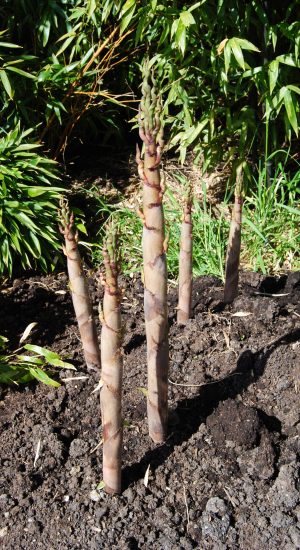
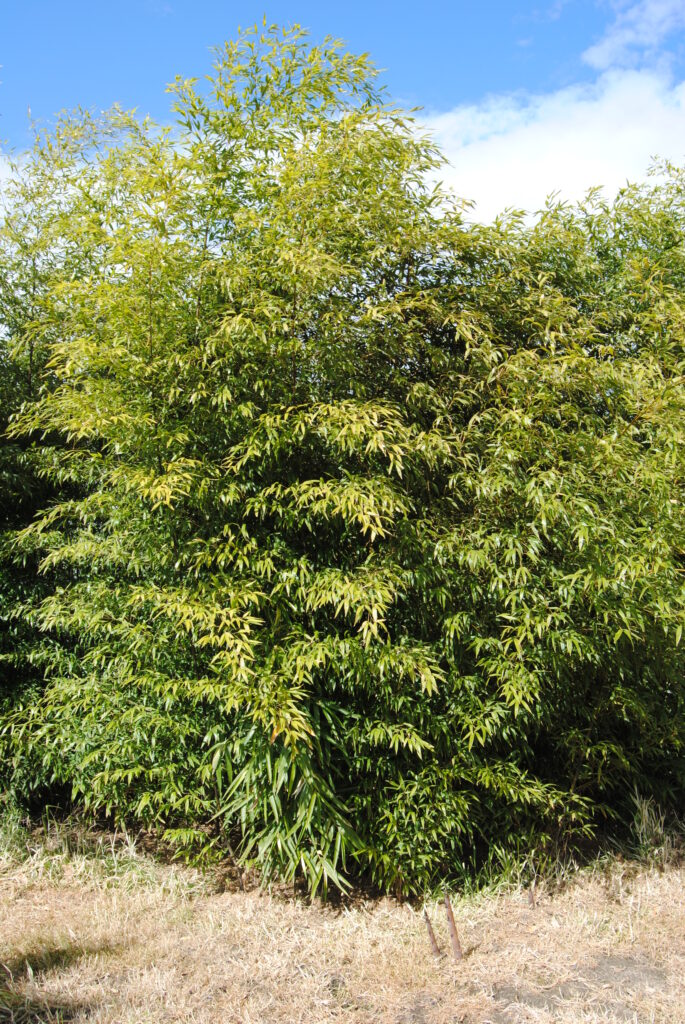
On the West Coast we thin our bamboo in the winter. In other areas, thin your bamboo when the new culms (bamboo canes) are just starting to open up with branches.
Cut the canes that are discolored, comparatively small or leaning over.
To make your bamboo beautiful expose the culms for all to see by pulling off the lower branches. If you pull down on a branch hard it will pop off cleanly at the culm.
If you would like to control the height of your bamboo you can cut out the culms that are shorter or taller than you like. A bamboo cane can be cut how ever you choose and that culm will never grow taller for the life of it.
Bamboo culms shoot up from the ground at the thickness that they will have for their entire life and after about 6 – 8 weeks they will be at their maximum height. Once a bamboo has completed the shooting period, it will only grow new branches and roughly double its leaf mass each following year.
Note: It’s usually better to grow a bamboo rated taller than you need because it’s so easy to control its height. If you choose a bamboo that ends up maturing at a shorter height than you want, there is less you can do about it.
are the variety, whether pot grown or field dug, and the time of year of order placement. In late summer and fall, after the bamboos plants have shot, they are substantially larger than they are in the spring. Sometimes plants over 1 metre in height, being shipped outside of Greater Vancouver, and The Fraser Valley, need to be topped, or the longer canes may need to be broken, to fit into our packaging. If a bamboo cane needs to be broken to fit into its packaging, just splint it with a small piece of bamboo, or wood, and it will grow on as if nothing happened. Our clumping bamboos usually have more canes in relation to pot size, but are shorter than the running bamboos. Note that height, and cane quantity, does not equal a more vigorous plant. Young stock, with plenty of healthy bamboo rhizomes, is our goal.
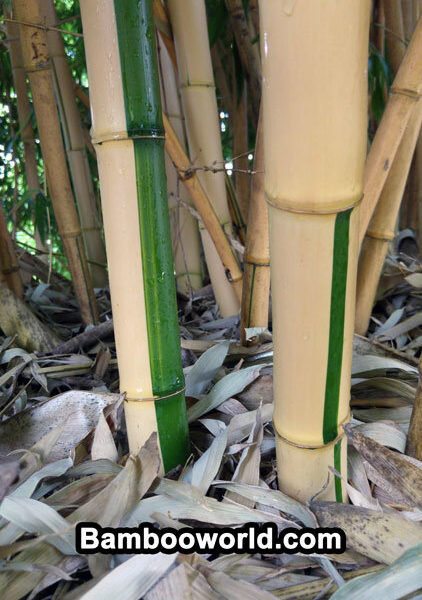
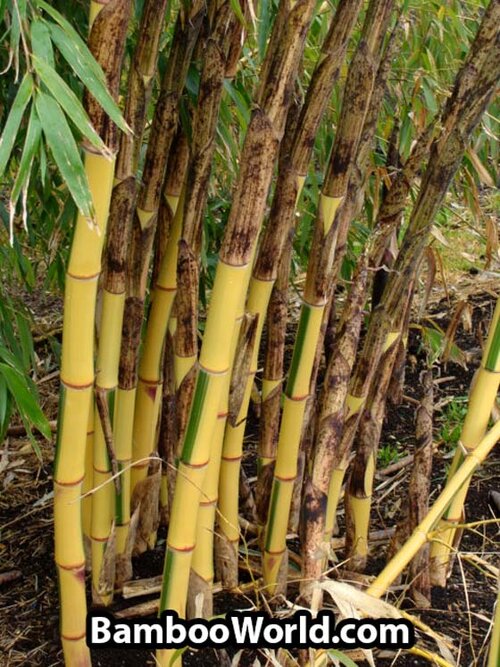
We use standard nursery industry sized pots.
#1=one gallon (1 to 3 feet tall, 1 to 3 canes)
#2=two gallon (1.5 to 4 feet tall, 1 to 4 canes)
#3=three gallon (2 to 3 feet tall, 1 to 5 canes)
#5=five gallon (3 – 5 feet tall, 1 to 5 canes
#7=seven gallon (4 – 7 feet tall, 1 to 5 canes)
#10=ten gallon (7 – 10 feet tall, 1 to 5 canes)
#15=fifteen gallon (11 – 15 feet tall, 1 to 5 canes)
#20=twenty gallon container (13 to 18 feet tall, 1 to 5 canes)
#25=twenty five gallon container (15 feet and up, 1 to 5 canes)
Here in the lower mainland of British Columbia and Vancouver Island we can plant bamboo anytime of the year as long as the ground is not frozen.
In locations that experience extreme winter conditions it is best to plant in the spring or summer. In extreme cold areas, the longer the bamboo plant is in the ground before it freezes the better.
Generally speaking, if your soil, water and light conditions are average and the bamboo is planted into the ground for 60 days with temperatures above 10 C, it should root in nicely.
Bamboo plants are surface plants with shallow roots so very little soil preparation is needed. Bamboo prefers light airy soil that is high in organic material but will grow in just about any soil as long as it’s not constantly wet (bog conditions). If lawn grass will grow where your bamboo is going to be planted, bamboo should be fine there also.
Plant your bamboo into the ground so that the surface of the soil in the pot is at the same level as the surface of the ground that you are planting it in.
Along the West Coast we fertilize in March and then again in late August. In other areas the Bamboo should be fed in early spring just before the shoots come up. A slow release lawn fertilizer with a 3-1-2 ratio of the numbers and added micro-nutrients will work well.
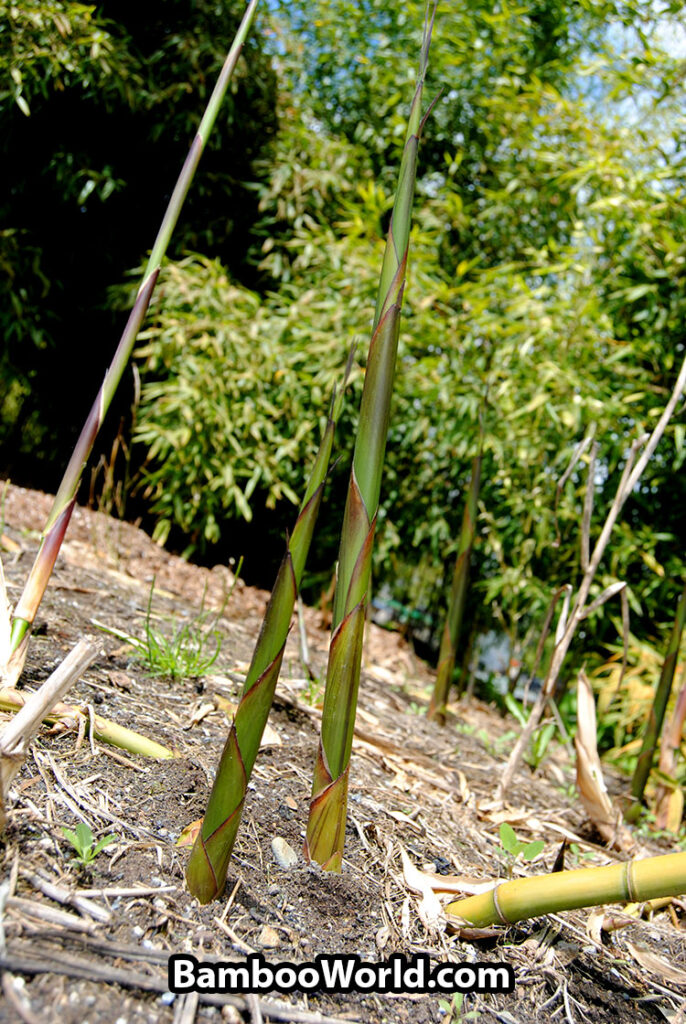
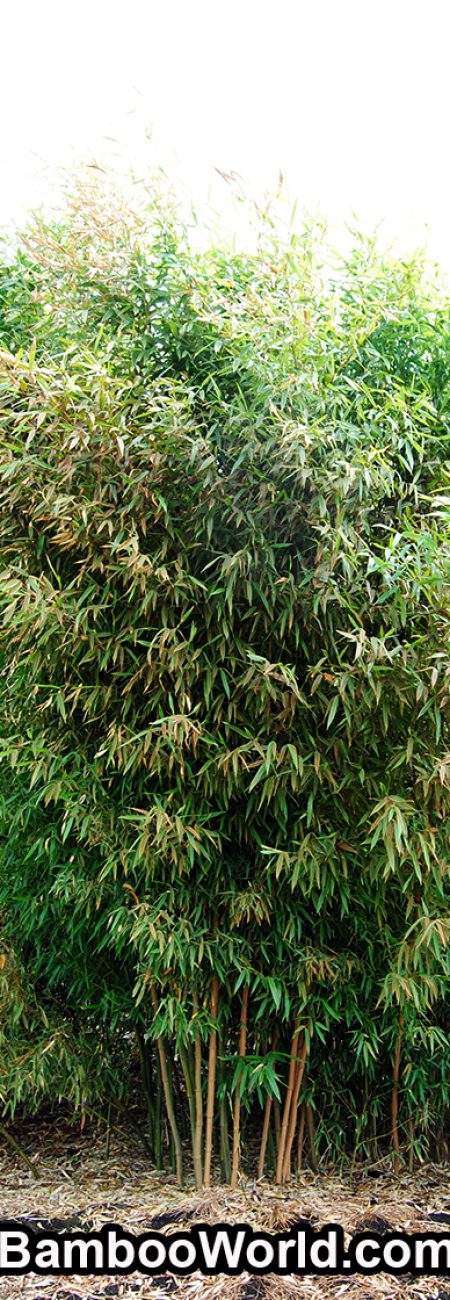
The irrigation schedule in every location is different so If you’re unsure of how much water to give your bamboo plant, watch the leaves. They will curl into themselves as the plant becomes dry and at this point you’ll know its time to water. During the growth period when the bamboo is shooting and when exposed to dry winds or in warmer temperatures it will require more water than usual.
It’s better to let a bamboo plant go a little dry than to over water it. You will know if a bamboo plant is a little dry because the leaves will roll into themselves, but once watered, the leaves will open back up within a few hours, so you will quickly learn when your bamboo plant needs to be watered.
The most common way to kill a bamboo plant is to over water it. If the tips of your leaves are turning brown, it’s a sign of too much watering. Cease watering your bamboo plant and wait until the leaves start to curl up into themselves before you water again.
In extreme cases of over watering the leaves of a bamboo will curl into themselves and have a similar look of when it’s too dry. If the soil around your bamboo plant is soaking wet and the leaves are curled up into themselves, you may want to spray your bamboo with a fungicide because it has been over-watered to the extreme.
To know what is currently happening with a bamboo plant, look at the newest leaves that are emerging at the ends of the branches.
This is usually a sign of too much water so cease or reduce watering your Bamboo plant immediately. Over watering is the most common mistake when growing bamboo.
If you are unsure how much water to give your Bamboo plant, watch the leaves they will curl into themselves as the plant becomes dry and at this point you will know its time to water. Its better to let the Bamboo go a little dry than to over water. The Bamboo leaves will open back up within a few hours and you will quickly learn when your Bamboo needs to be watered.
When growing potted bamboo plants indoors, the single most important factor to consider is the amount of water to give them. With less circulation, and lower light conditions, its easy to over-water them. A good way to tell if you have over-watered your bamboo plants is if you start to notice dead leaf tips. Bamboo is thought of as a moisture loving plant, but without good drainage it suffers. If you suspect your potting soil is too heavy, and the drainage is not ideal, try adding perlite to it. If your bamboo plant is too dry the leaves will roll into themselves, and in extreme cases look like cactus needles.; they do this to reduce the leaf area that is exposed to evaporation. Its better to let a bamboo plant go a little dry than to over water it. Once a dry bamboo plant is watered the leaves will usually unravel themselves, and look fine within a few hours. The best way to determine your watering schedule, when growing potted bamboo plants indoors, is to let them dry out slightly between watering.
Another factor to consider when growing potted bamboo plants indoors, is humidity levels. A periodic light misting of the leaves can be very beneficial, but you need to keep in mind how easily they can be over watered indoors. Placing your pot onto an oversize drip tray filled with water, and gravel, is an easy way to raise the humidity levels in the immediate area around your bamboo plant. Be sure to keep the water level below the gravel level, so the potted bamboo plant is not sitting in water.
Food is another factor to consider when growing a bamboo plant indoors in a pot. You want the leaves to be a dark green color, so if you notice them slowly yellowing (going chlorotic), it might be time to fertilize the bamboo plant. Keep in mind that the leaves can look chlorotic when over fertilizing also, but usually the color change is more immediate.
It is not uncommon for bamboo plants to drop a lot of their leaves once put indoors. To know what is currently happening with a bamboo plant, look at the newest leaves at the ends of the branches; the emerging leaves. If you see signs of stress, putting it outdoors for a couple of months can do wonders to help it bounce back.
If you don’t have room for your potted bamboo plants inside of your house, but you have a cool garage or shed, you can store them inside of it over the winter. The temperature should be between 1 and 5 degrees Celsius.
Most of our bamboo plants do best outdoors, except for the list below, which contains some of the best varieties to try indoors:
Most of our bamboo plants do best outdoors, except for the list below, which contains some of the best varieties to try indoors:
Bright Light
Phyllostachys aurea ‘Flavescens Inversa’
Phyllostachys aurea ‘Holochrysa’
Phyllostachys aurea ‘koi’
Phyllostachys nigra
Semiarundinaria fastuosa
Semiarundinaria fastuosa viridis
Moderate Light
Chimonobambusa marmorea
Pleioblastus viridi-striatus
Psuedosasa japonica
Low Light
Hibanobambusa tranquillans Shiroshima
Indocalamus latifolius
Indocalamus tessellatus
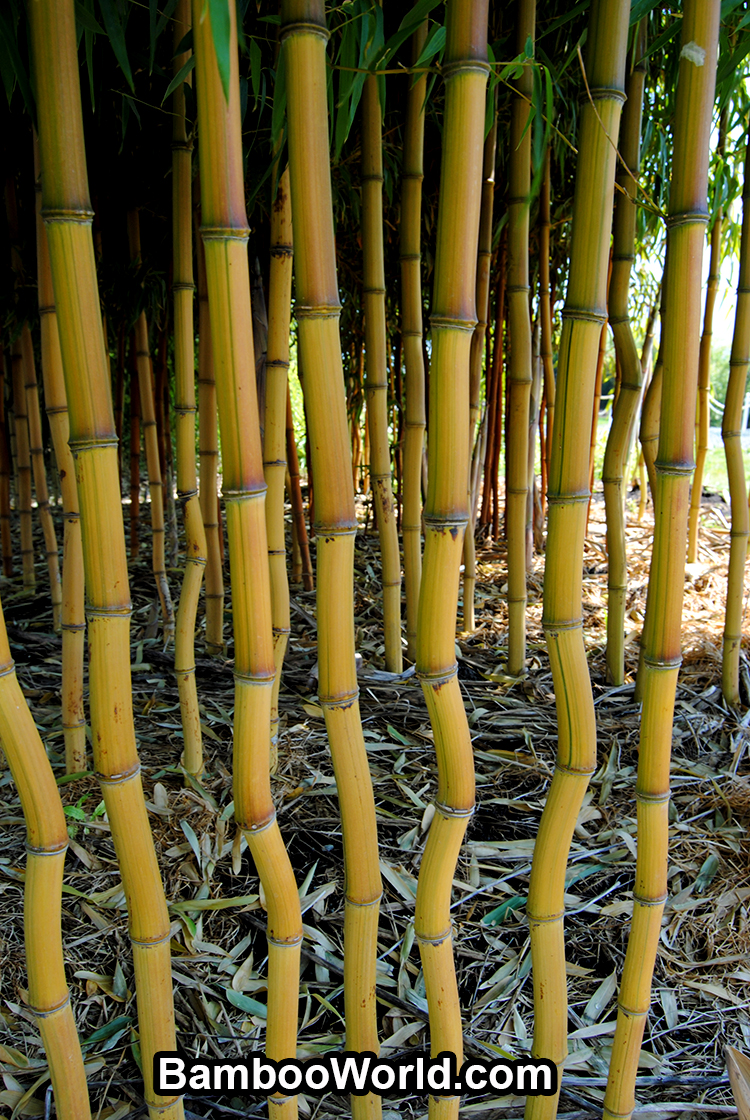
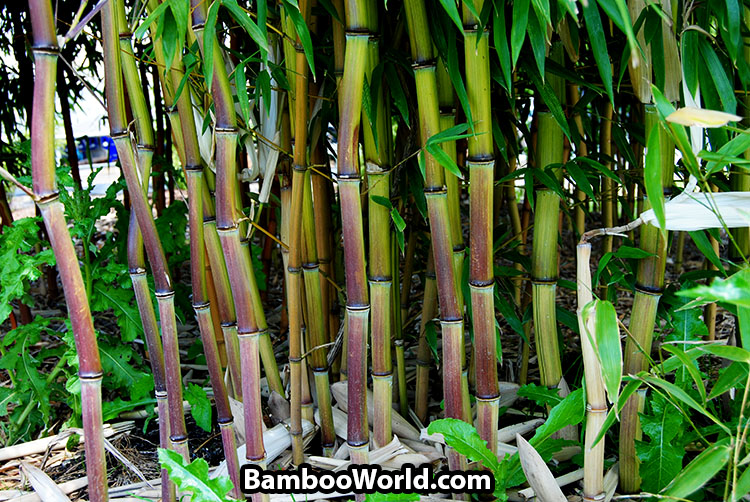
Are bamboo poles easy to cut?
Bamboo is very easy to cut with any type of saw however we recommend using a finishing saw blade or a hack saw with many teeth in order to obtain the cleanest cut.
How do you split a bamboo pole?
in order to split a bamboo pole vertically:
1) Prop the thin end of the bamboo pole against a wall or something solid and place the thick end of the bamboo pole between your knees.
2) Place the sharp end of a thick blade, hatchet, axe or machete onto the the bamboo pole that you want to split.
3) Tap the blunt end of the blade of what ever you are using with a hammer to start splitting the bamboo pole down the first foot or so of it.
4) Once your bamboo pole is split down a foot or two of its length, pull each half of it apart quickly and it will separate along a straight even line similar to the way fabric will split when pulled apart.
How do you hollow out a bamboo pole?
Plunge a shovel handle, piece of re-bar or broom handle inside of the center of your bamboo pole and the inner membranes that are at each node will break out easily
Can bamboo canes, poles or fencing be painted?
Yes bamboo poles, stakes or canes can be painted or stained.
If you want to make your bamboo shine, you can use a clear coat lacquer. Marine paint also works well. You can also stain it, but you will want to let the bamboo weather untreated for a year, before applying the stain, so it adheres better to the bamboo.
How do I clean a bamboo pole, bamboo cane or bamboo stake?
A simple and easy way to clean a bamboo cane, pole, fence or stake, is to rub it while it’s dry with steel wool.
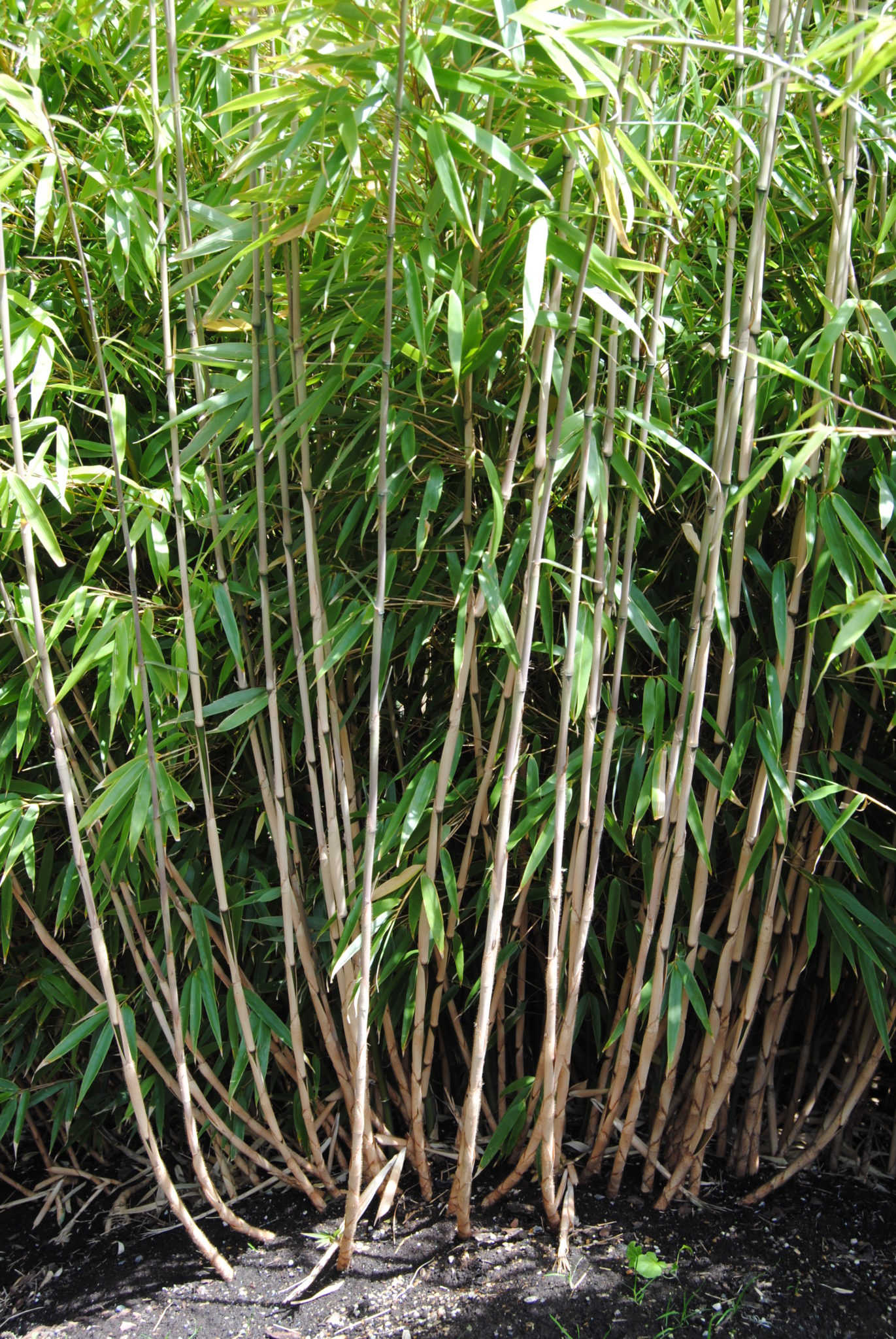
Here in the lower mainland of British Columbia and Vancouver Island we can plant bamboo anytime of the year as long as the ground is not frozen.
In locations that experience extreme winter conditions it is best to plant in the spring or summer. In extreme cold areas, the longer the bamboo plant is in the ground before it freezes the better.
Generally speaking, if your soil, water and light conditions are average and the bamboo is planted into the ground for 60 days with temperatures above 10 C, it should root in nicely.
